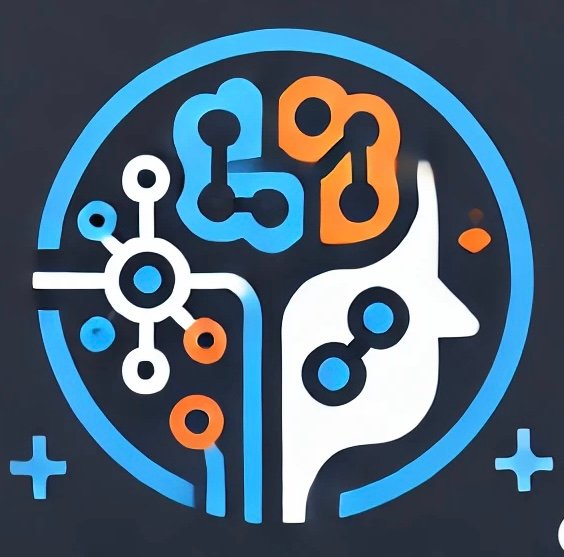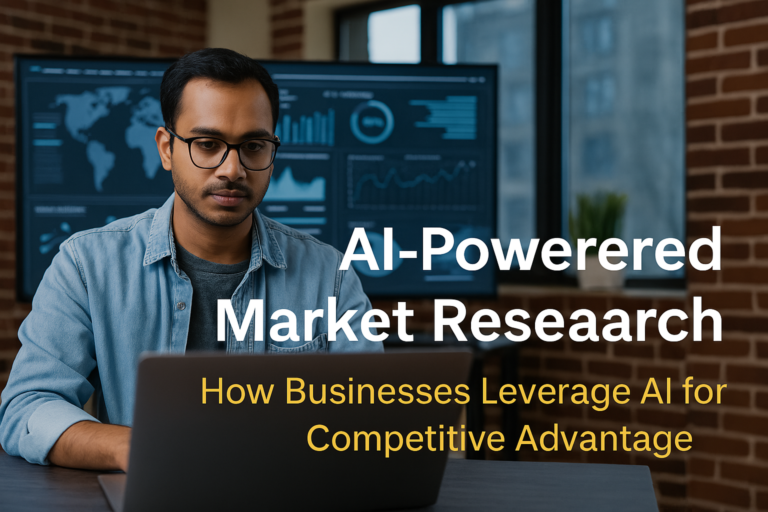Introduction

In today’s fast-paced business environment, staying ahead of the competition isn’t just about working harder—it’s about working smarter. Artificial intelligence (AI) has emerged as the game-changer that’s redefining how businesses analyze their competition and shape their strategies. By 2025, companies that aren’t leveraging AI for competitive analysis might as well be using a compass in the age of GPS.
Think about it: while your team manually gathers competitive intelligence—a process that could take weeks—your AI-powered competitors are analyzing market shifts, predicting trends, and pivoting their strategies in near real-time. The gap between AI-adopters and traditional businesses is widening by the day.
In this comprehensive guide, you’ll discover how to harness AI for competitive analysis and business strategy in 2025. We’ll cover everything from the fundamentals of AI-driven competitive intelligence to practical implementation steps, common challenges, and future trends. Whether you’re a startup founder, a marketing executive, or a business analyst, this article will equip you with the knowledge to transform your competitive strategy using AI.
Table of Contents
Background & Importance
What is AI for Competitive Analysis?
AI for competitive analysis refers to the use of artificial intelligence technologies to gather, process, and analyze data about competitors, market trends, and industry developments. Unlike traditional methods that rely heavily on manual research and human interpretation, AI systems can automatically collect vast amounts of data from multiple sources, identify patterns, and generate actionable insights at unprecedented speeds.
These systems typically employ various technologies:
- Machine learning algorithms that improve their accuracy over time
- Natural language processing (NLP) to analyze text from news articles, social media, and other sources
- Computer vision to extract information from images and videos
- Predictive analytics to forecast market trends and competitor actions
The Growing Role of AI in Business Strategy
The adoption of AI for business intelligence and competitive analysis has accelerated dramatically in recent years. According to a report by McKinsey, businesses that fully integrate AI into their operations can expect to see a 20-30% increase in EBITDA compared to non-adopters in the same industry.
The statistics tell a compelling story:
- 85% of enterprises are using AI in some capacity as of 2024, up from 55% in 2020
- Companies using AI for competitive analysis report 37% more accurate market predictions
- 63% of businesses say AI has helped them identify new market opportunities before competitors
The stakes are especially high in 2025. With global markets becoming increasingly volatile and competitive landscapes shifting rapidly, businesses need the speed and accuracy that only AI can provide to stay competitive.
Key Benefits & Challenges
Top Benefits of AI for Competitive Analysis
Faster & More Accurate Data Analysis
Traditional competitive analysis might take weeks or even months to complete. AI systems can continuously monitor and analyze competitor activities across multiple channels in real-time. For example, Walmart uses AI to track pricing changes across competitors’ websites, allowing them to adjust their pricing strategy multiple times per day if necessary.
Improved Market Trend Predictions
AI excels at identifying emerging patterns before they become obvious. Netflix famously uses predictive analytics to not only recommend content to users but also to predict which types of shows will become popular, informing their content creation strategy before competitors can react.
Enhanced Decision-Making with Real-Time Insights
When Target implemented AI-powered analytics, they were able to reduce their decision-making cycle from weeks to days. Their system continuously monitors competitor promotions, supply chain disruptions, and customer behavior changes, allowing executives to make informed decisions quickly.
Cost Reduction in Research & Strategy Planning
According to a Deloitte survey, companies using AI for competitive analysis report an average 30% reduction in market research costs. This comes from automating data collection and preliminary analysis, allowing human analysts to focus on higher-value activities.
Automation of Competitor Monitoring
AI tools like Crayon and Kompyte can automatically track changes to competitors’ websites, pricing, product features, and marketing campaigns. This level of continuous monitoring would be impossible with manual methods. For instance, a mid-sized SaaS company might track 20+ competitors across 50+ data points daily—a task that would require several full-time employees without AI.
Common Challenges & How to Overcome Them
Data Privacy Concerns & Ethical Implications
While AI can gather vast amounts of data, businesses must ensure they’re collecting information ethically and legally. The challenge intensified with the implementation of GDPR, CCPA, and other privacy regulations worldwide.
Solution: Implement a robust data governance framework that ensures compliance with relevant regulations. Focus on publicly available data and use anonymized datasets. Tools like OneTrust and BigID can help manage compliance across different jurisdictions.
High Initial Implementation Costs
The upfront investment for AI implementation can be substantial, with enterprise-level solutions often costing hundreds of thousands of dollars.
Solution: Start small with focused AI applications that deliver quick ROI. Consider SaaS solutions like SEMrush or Crayon that offer AI-powered competitive analysis without the need for extensive in-house infrastructure. Many vendors now offer tiered pricing models that allow businesses to scale their AI usage as they grow.
Need for Skilled AI Professionals
The talent gap in AI expertise remains significant, with demand far outpacing supply. According to LinkedIn data, AI specialists are among the top emerging jobs worldwide.
Solution: Invest in upskilling existing employees through programs like Coursera’s AI for Business specialization. Consider partnering with AI consultancies or using managed AI services from providers like IBM, Google, or Microsoft that require less in-house expertise.
Real-World Use Cases & Applications
Retail Industry: Amazon’s Competitive Edge
Amazon leverages AI to analyze competitor pricing strategies across millions of products. Their dynamic pricing algorithm makes approximately 2.5 million price changes daily, compared to just 50,000 for Walmart. This AI-powered approach has helped Amazon maintain its competitive edge in e-commerce.
The system doesn’t just react to competitor prices; it predicts when competitors are likely to change prices based on historical patterns and adjusts Amazon’s pricing proactively. This predictive capability gives Amazon a 24-48 hour advantage in many cases.
Financial Services: JPMorgan Chase’s COIN System
JPMorgan Chase developed a system called COIN (Contract Intelligence) that uses AI to analyze legal documents and extract important data points. This allows them to quickly assess competitor offerings and identify market gaps.
The system has reduced the time needed to review 12,000 annual commercial credit agreements from 360,000 hours to just 36,000 hours—a 90% reduction. This efficiency allows JPMorgan to respond more quickly to competitive threats and market opportunities.
Tech Industry: Microsoft’s AI-Driven Product Development
Microsoft uses AI to analyze user feedback across its products and competitors’ offerings. This approach helped them identify gaps in the collaboration software market, leading to the development of Microsoft Teams.
By analyzing patterns in user complaints about competing products like Slack and Google Workspace, Microsoft was able to prioritize features that addressed common pain points. This strategy helped Teams grow from 13 million daily active users in 2019 to over 250 million in 2024.
Step-by-Step Example: How AI Helps Startups Analyze Market Gaps
Let’s walk through a practical example of how a fintech startup used AI to identify a market opportunity:
- Data Collection: The startup used AI tools to gather data on existing financial apps, including feature sets, pricing models, and user reviews.
- Sentiment Analysis: Using NLP, they analyzed over 100,000 user reviews to identify common complaints and unmet needs across competitor products.
- Feature Gap Analysis: The AI system compared feature sets across competitors and identified specific functionality that was consistently requested but not well-implemented.
- Market Opportunity Sizing: By analyzing search trends and social media conversations, the AI estimated the potential market size for a solution addressing the identified gaps.
- Competitive Positioning: The startup used these insights to develop a product that specifically addressed the unmet needs, with marketing messaging that highlighted these differentiators.
The result? The startup secured $5 million in funding and acquired 50,000 users within six months of launch, specifically because they could demonstrate a data-driven approach to identifying and addressing market gaps.
Expert Insights & Thought Leadership
Industry Leaders on AI Competitive Analysis
Satya Nadella, CEO of Microsoft, recently stated: “AI is the defining technology of our time. Companies that harness it effectively for competitive insights will see a disproportionate advantage in market share and growth rate.”
Similarly, Ginni Rometty, former CEO of IBM, emphasized: “In the age of AI, competitive advantage doesn’t go to the company with the most data, but to the one that can turn that data into insights and actions faster than others.”
Andrew Ng, AI pioneer and founder of Landing AI, offers a practical perspective: “Don’t start with AI; start with a business problem. The most successful AI implementations for competitive analysis begin with a clear understanding of what decisions you need to inform.”
AI vs. Traditional Market Analysis Methods
| Aspect | Traditional Methods | AI-Powered Approaches |
| Speed | Weeks to months | Hours to days |
| Data Volume | Limited by human capacity | Can process millions of data points |
| Update Frequency | Periodic (quarterly/annually) | Continuous (real-time) |
| Bias | Subject to human bias | Algorithmic bias (can be mitigated) |
| Cost | High ongoing labor costs | Higher upfront cost, lower ongoing expenses |
| Insight Generation | Experience-based | Data-driven with pattern recognition |
The most effective approach combines AI’s processing power with human strategic thinking. As Kai-Fu Lee, AI expert and venture capitalist, notes: “AI is excellent at identifying patterns humans might miss, but humans remain essential for understanding context and making strategic decisions based on those patterns.”
Step-by-Step Guide or Action Plan
Step 1: Identify Key Competitors & Market Trends
Begin by mapping your competitive landscape. Use AI tools like Crayon or Kompyte to create a comprehensive competitor database. These tools can automatically identify direct and indirect competitors based on keywords, market positioning, and customer overlap.
For market trends, leverage tools like Exploding Topics or Google Trends with AI analysis layers to identify emerging patterns. AI can help you spot trends months before they become mainstream by analyzing early signals across news sources, social media, and academic publications.
Practical Example: Peloton used AI-powered trend analysis to identify the convergence of home fitness and connected technology before launching their product. This early trend identification gave them a significant first-mover advantage in the interactive fitness equipment market.
Step 2: Choose AI Tools for Data Collection & Analysis
Select appropriate AI tools based on your specific needs and budget:
- Comprehensive competitive intelligence platforms:
- SEO and content analysis:
- SEMrush – Comprehensive SEO competitor analysis
- Ahrefs – Excellent for backlink and content gap analysis
- BrightEdge – Strong in AI-powered content optimization
- Social media and sentiment analysis:
- Brandwatch – Powerful social listening capabilities
- Sprinklr – Enterprise-level social media intelligence
- Talkwalker – Strong in visual content analysis
- Advanced analytics platforms:
- IBM Watson – Enterprise-grade AI capabilities
- Google Cloud AI – Strong in machine learning and prediction
- Microsoft Azure AI – Excellent for large-scale data processing
Implementation Tip: Start with a focused use case rather than trying to implement all capabilities at once. For example, begin with monitoring competitor content strategy before expanding to pricing analysis and product feature tracking.
Step 3: Leverage AI for Predictive Analytics & Strategic Planning
Once you have the data flowing, use AI to generate forward-looking insights:
- Competitor Movement Prediction: Train machine learning models on historical competitor data to predict future product launches, pricing changes, or marketing campaigns.
- Market Opportunity Identification: Use clustering algorithms to identify underserved customer segments or product feature gaps.
- Scenario Planning: Employ AI simulations to model different competitive scenarios and test strategic responses.
- Sentiment Trend Analysis: Track changing customer attitudes toward your company and competitors to identify emerging reputation risks or opportunities.
Case Study: Netflix uses predictive analytics to forecast which content categories will grow in popularity, allowing them to commission new shows in emerging genres before competitors recognize the trend. This approach helped them identify the true crime documentary trend early, leading to hits like “Making a Murderer” and “Tiger King.”
Step 4: Implement Insights into Business Decisions
Transform AI-generated insights into actionable strategies:
- Create AI-Powered Competitive Battlecards: Develop dynamic sales enablement tools that update automatically as competitor information changes.
- Establish Competitive Response Protocols: Define triggers and response plans for competitor actions (e.g., automatic price adjustments when competitors launch promotions).
- Develop Preemptive Product Roadmaps: Adjust product development priorities based on predicted competitor moves and market trends.
- Optimize Marketing Messaging: Use competitor positioning analysis to identify and communicate your unique value proposition more effectively.
Real-World Example: Airbnb uses AI-generated insights to identify emerging travel destinations before they become popular. This allows them to focus host recruitment efforts and marketing campaigns on these areas, establishing market leadership before competitors recognize the opportunity.
Step 5: Continuously Refine Strategy Using AI-Generated Insights
Implement a continuous improvement cycle:
- Establish Key Performance Indicators (KPIs): Define metrics to evaluate the effectiveness of your AI-driven competitive strategy.
- Implement Feedback Loops: Capture outcomes of strategic decisions to refine AI models and improve future predictions.
- Conduct Regular Strategy Reviews: Hold quarterly sessions to assess competitive position and adjust strategies based on AI insights.
- Invest in Ongoing AI Training: Regularly update your AI systems with new data and refinements to improve accuracy over time.
Expert Tip: According to Thomas H. Davenport, Professor of IT and Management at Babson College, “The most successful AI implementations for competitive analysis are those that combine machine intelligence with human expertise in a continuous learning loop.”
Common Myths & Misconceptions
Myth #1 – AI Replaces Human Strategists
The Myth: Once you implement AI for competitive analysis, you can reduce or eliminate your strategy team.
The Reality: AI is a powerful tool that augments human strategists rather than replacing them. While AI excels at processing vast amounts of data and identifying patterns, human judgment remains essential for interpreting these insights within broader business contexts.
AI can tell you that a competitor has changed their pricing strategy, but it takes human experience to understand why they made that change and what it means for your industry. The most effective approach is collaborative intelligence—combining AI’s analytical power with human creativity and judgment.
Example: When Microsoft implemented AI for competitive analysis, they didn’t reduce their strategy team. Instead, they repurposed analysts from data gathering to higher-value activities like scenario planning and strategic response development. This human+machine approach led to a 42% increase in successful competitive responses.
Myth #2 – AI is Only for Big Corporations
The Myth: Small businesses can’t afford or effectively implement AI for competitive analysis.
The Reality: While enterprise-level AI solutions can be expensive, there are now numerous affordable options specifically designed for small and medium-sized businesses. Many AI tools offer tiered pricing models that allow smaller companies to start with basic functionality and scale up as they grow.
For example, tools like SpyFu and SE Ranking offer competitive SEO analysis with AI capabilities starting at less than $100 per month. Even more sophisticated tools like Crayon offer small business plans.
Case Study: A boutique digital marketing agency with just 15 employees implemented an AI-powered competitive analysis tool that automatically tracked 25 competitors across 30 data points. Within three months, they identified a gap in service offerings that led to a new revenue stream worth $250,000 annually—a 700% ROI on their AI investment.
Myth #3 – AI Guarantees Instant Success
The Myth: Implementing AI for competitive analysis will immediately provide winning strategies.
The Reality: AI is not a magic solution that guarantees success. It requires proper implementation, high-quality data inputs, and thoughtful interpretation of results. Like any powerful tool, its effectiveness depends on how well it’s used.
Additionally, AI systems need time to learn and improve. The first insights may
Additionally, AI systems need time to learn and improve. The first insights may not be as valuable as those generated after several months of operation and refinement. Successful implementation requires patience, consistent data inputs, and regular system tuning.
Expert Insight: According to Dr. Kai-Fu Lee, “AI is not a silver bullet. It’s more like a powerful microscope that helps you see things you couldn’t see before. But you still need to know where to point it and how to interpret what you see.”
Implementation Reality: Starbucks spent over six months training its AI competitive analysis system before seeing truly actionable insights. The initial period focused on data collection and model training. Their patience paid off with a system that now helps them predict competitor store openings with 85% accuracy, allowing for preemptive marketing campaigns in affected areas.
Future Trends & Predictions
The Evolution of AI in Business Strategy Beyond 2025
As we look ahead, several emerging trends will shape how businesses use AI for competitive analysis:
- Integrated Decision Intelligence Platforms
By 2027, we’ll likely see the emergence of comprehensive AI systems that not only analyze competition but also automatically implement tactical responses. For example, future systems might detect a competitor’s price drop and automatically adjust your prices within parameters set by management.
A Gartner report predicts that by 2027, over 30% of large organizations will be using decision intelligence platforms that combine data, analytics, and AI to automate small decisions and augment larger ones.
- Emotion AI and Deeper Customer Understanding
Next-generation competitive analysis will incorporate “emotion AI” that can detect and analyze customer emotional responses to both your products and competitors’ offerings. This technology analyzes facial expressions, voice tone, text sentiment, and physiological indicators to provide deeper insights into customer preferences.
For example, an AI system might determine that while customers say they prefer a competitor’s pricing model, their emotional response indicates frustration with the complexity, revealing an opportunity for a simpler alternative.
- Cross-Industry Pattern Recognition
Future AI systems will excel at identifying successful strategies from completely different industries that could be adapted to your market. By analyzing patterns across diverse sectors, these systems will help businesses implement innovative approaches before competitors recognize their relevance.
Tesla successfully applied this cross-industry approach by bringing tech industry practices to automotive manufacturing. Future AI will systematize this type of cross-pollination.
Upcoming AI Advancements in Competitive Intelligence
Several specific technological advancements will enhance competitive intelligence capabilities:
- Quantum Computing for Complex Competitive Simulations
As quantum computing becomes more accessible, businesses will be able to run complex competitive simulations that model thousands of variables simultaneously. This will enable more accurate prediction of market responses to strategic changes.
IBM and other major tech companies are already working on quantum solutions for business intelligence that could be commercially viable by 2027.
- Augmented Reality Competitive Analysis
Imagine walking through a competitor’s store while your AR glasses overlay real-time pricing comparisons, customer sentiment data, and product gap analysis. This technology is already in development and will likely be mainstream for business use by 2026.
Walmart is currently testing AR glasses that help store managers visualize competitor pricing and merchandising strategies overlaid on their store layout.
- Autonomous Competitive Agents
AI systems will evolve from passive analysis tools to active “agents” that continuously monitor competitors, identify threats and opportunities, and suggest or even implement responses without human intervention for routine matters.
These agents will operate 24/7, ensuring your business never misses a competitive move regardless of time zone or business hours.
The Role of AI in Ethical & Sustainable Business Decisions
As AI becomes more integrated into competitive strategy, ethical considerations will move to the forefront:
- Ethical Competitive Intelligence
Future AI systems will include built-in ethical guardrails that prevent crossing legal or ethical boundaries in competitive intelligence gathering. These systems will automatically flag potentially problematic data collection methods and suggest alternatives.
The EU AI Act and similar regulations worldwide are already shaping how these systems will operate.
- Sustainability Impact Analysis
Next-generation competitive analysis tools will incorporate sustainability metrics, helping businesses understand how their environmental and social impact compares to competitors. This will become increasingly important as consumers and regulators place greater emphasis on sustainable business practices.
Unilever already uses AI to analyze competitors’ sustainability claims and practices, identifying areas where they can differentiate themselves through more substantive environmental commitments.
- Collaborative AI for Industry Challenges
Perhaps most interesting is the emergence of collaborative AI platforms where companies within an industry can collectively address common challenges while maintaining competitive differentiation in other areas.
For example, pharmaceutical companies are exploring collaborative AI systems to accelerate drug discovery while maintaining competition in marketing and distribution. This trend will likely expand to other industries facing complex systemic challenges.
Conclusion & Call to Action
The integration of AI into competitive analysis and business strategy represents a fundamental shift in how companies understand their markets and make decisions. In 2025, this isn’t just a competitive advantage—it’s becoming table stakes for business survival.
Let’s recap the key takeaways:
- AI transforms competitive analysis through faster data processing, pattern recognition, and predictive capabilities that human analysts alone cannot match.
- The benefits—including real-time insights, cost reduction, and improved forecasting—far outweigh the challenges of implementation.
- Companies across industries are already seeing concrete results from AI-powered competitive analysis, from retail to finance to technology.
- Implementation follows a clear path: identify competitors and trends, choose appropriate tools, leverage predictive capabilities, implement insights, and continuously refine your approach.
- The future will bring even more sophisticated AI capabilities, including emotion analysis, cross-industry pattern recognition, and autonomous competitive agents.
The question is no longer whether to adopt AI for competitive analysis, but how quickly and effectively you can implement it. Every day without these capabilities is a day your competitors might be gaining insights that you’re missing.
Start by assessing your current competitive analysis processes. Identify the biggest gaps or inefficiencies, and explore AI solutions specifically designed to address those challenges. Remember that you don’t need to implement everything at once—start with focused applications that deliver clear ROI, then expand from there.
Looking to dive deeper into specific AI tools for market research? Check out our related articles:
The AI revolution in competitive analysis is here, and the window for early adoption advantage is closing rapidly. Will your business be a leader or a follower in this transformation? The choice you make today will shape your competitive position for years to come.




